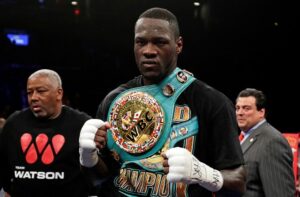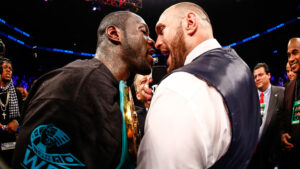Tyson Fury, who features this Saturday night on the Windsor Park undercard, has a potential World title challenge against WBC heavyweight champion Deontay Wilder on the cards later this year, provided he emerges triumphant on Saturday night.
In a stunning revelation, Fury recently declared that Wilder will be next, in what would surely constitute a modern-day heavyweight superfight and perhaps the best possible alternative to the unification showdown between Wilder and Anthony Joshua – which inexplicably failed to materialise this year.

Fury, who was born on the outskirts of Manchester with family connections to Ireland and Belfast, has fought in the city on numerous occasions in the past; most recently in 2012 when he soundly outpointed Kevin ‘Kingpin’ Johnson at the famous Ulster Hall.
Now, he is up against former World title challenger in Italian southpaw Franscisco Pianeta, a respectable opponent who was stopped in six rounds by Wladimir Klitschko in 2013; albeit a faded contender whose best days – which probably would not be enough to seriously perturb any of the recent champions – are probably behind him.
General consensus – although not wholly corresponding with the current bookmakers’ assessment – dictates that, at the moment, it is somewhat too early for Fury to challenge someone as athletic and powerful as Wilder, especially considering his less-than-spectacular performance against Sefer Seferi in June.

It would not be uncharitable to describe it as accounts, a farcical affair which, it has to be said, was characterised by little meaningful action on the part of both fighters; as opposed to clinching and incessant posturing.
However, Fury probably will be heartened by the fact that he has defied consensus before with his sensational upset unanimous-decision win over Wladimir Klitschko on away soil in November 2015, effortlessly outjabbing the reigning champion and winning nearly every round in the process.
The Seferi debacle was all too typical of the Fury persona, which can be encapsulated as a riddle wrapped in an enigma.

He is, after all, by his own admission, a thoroughly unpredictable character whose turbulent mood swings seemingly reflect his in-ring displays. Sometimes, Fury shows flashes of brilliance whilst flattering to deceive. In other fights, he has been undeniably pretty to watch: and in a few of his fights, he has looked virtually unstoppable, raining down barrages of quick-fire combinations on hapless opponents.
It is important to ponder the question as to whether the Fury, although anointed by many observers as the technically superior fighter to both Joshua and Wilder, can salvage whatever may be left of his athletic prime after spending two-and-a-half years out of the ring suffering with depression and issues with drugs and alcohol.
Whatever the case, expectations are high for his return and analogies have already been drawn up by some of the more hyperbolic subsections of Fury’s fanbase between him and Muhammad Ali; a fighter who was also renowned for his controversial, charismatic nature and who also returned to the ring after an involuntary absence of several years with the express aim of reclaiming the heavyweight championship.

Of course, superficial similarities in style – with Fury’s penchant for a twinkle-toed back-pedalling that belies his gargantuan frame – have understandably prompted such comparisons.
However, it can be argued that aspects of Ali are visible in all three champion figures: lineal champion Fury – with his trademark left flicker; unified champion Joshua – the Olympic gold medallist usually adorned in all-white; and, finally, green and gold belt-holder Wilder – the polarising, inflammatory Southerner who fans absolutely love to hate.
Indeed, Wilder boasts a fearsome professional record of 40 fights and 40 wins – with 39 knockouts – but nevertheless, Fury’s scores of devoted fans are supremely confident that his size and skillset will be sufficient to overcome ‘The Bronze Bomber’ by nullifying his offensive dangers and inflicting a first loss on the American.
Fury insists that he is not attempting to evoke the past, unlike many other returning fighters before him, and that youthful freshness and forward-thinking innovation are crucial to his approach under new trainer Ben Davison.

Nevertheless, if it is the case that Ali’s accomplishments have inspired his return, at least in part, then it may be important for Fury to take into consideration also that Ali’s attempts at compensating for his ring rust and athletic decline by reinventing himself in the ring came with varying degrees of success.
Yes, a Wilder fight before the end of the year does not represent an ideal scenario for a fighter lacking adequate preparation against elite opponents. Moreover, although the parallels with Zaire 1974 are uncanny in this case, we can at the same time acknowledge that these historical comparisons are slightly overwrought.
Ultimately, the salient point is that the thousands watching in Windsor Park will find it difficult to contain their genuine excitement when beholding the sheer spectacle of Fury and Wilder confronting each other face to face in the ring, WWE style – something which speaks to the magnitude of this fight – as the defeated Francisco Pianeta despondently watches on in the background.

The key difference this time, however, from Fury’s invasion of the ring in January 2016 at the Barclays Center, is that the fight now actually appears to be a realistic possibility.
For Fury, fighting Wilder before the end of the year represents a perfect opportunity to upstage his nemeses Eddie Hearn and Anthony Joshua – and to permanently silence doubters, skeptics and writers in the process…
Article by: Navi Singh
Follow Navi on Twitter at: @hombre__obscuro